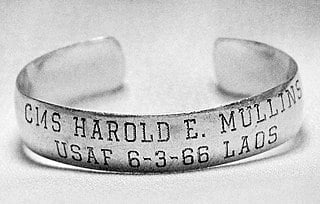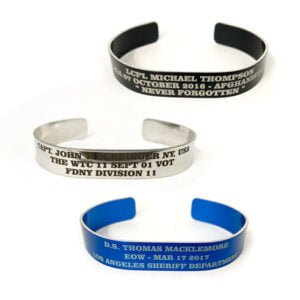We wear modern memorial bracelets to remember heroes and loved ones taken from us too soon. Though it seems clear these memorial bracelets were inspired by POW/MIA bracelets of the early 1970’s, wearing memorial bands and jewelry goes back much further in history.
The Mourning Armband
The origin of the mourning armband isn’t clear. But, this practice shows up throughout history. Many cultures have used it to remember the deceased.
 The black mourning band was traditionally worn on the left upper arm and made of fabric. Possibly one of the first documented cases of its use is seen in a portrait from 1614 of Princess Elizabeth Stuart, later, Queen of Bohemia. The portrait depicts her wearing the black armband. The belief is she wears it to honor her deceased brother, the Prince of Wales, Henry Frederick.
The black mourning band was traditionally worn on the left upper arm and made of fabric. Possibly one of the first documented cases of its use is seen in a portrait from 1614 of Princess Elizabeth Stuart, later, Queen of Bohemia. The portrait depicts her wearing the black armband. The belief is she wears it to honor her deceased brother, the Prince of Wales, Henry Frederick.
Regency and Victorian Era
In Regency and Victorian times, servants of the less affluent wore black armbands as a sign of a household in mourning. In contrast, servants of more affluent households were provided a set of black mourning clothes. Family members wore full black mourning attire as expected. However, instead of black mourning attire, military men in uniform wore the black mourning armband. These practices were in addition to a whole host of rules of etiquette surrounding mourning. Observed for a set period of time, then longer if one chose.
Note that mourning jewelry became popular as well. With the passing of her husband, Prince Albert, in 1861, Queen Victoria spent the following four decades wearing black crepe dress and mourning jewelry. Her popularity made it quite fashionable, prompting aristocrats and the wealthy to commission bracelets, rings and lockets memorializing their deceased loved ones. This jewelry commonly incorporated black enamel, jet, onyx and other dark or black materials. Also, it included the name of the deceased and sometimes locks of their hair.
Post Victorian Era
Post Victorian times, the black armband, instead of mourning attire, became more popular in the U.S. The high cost of a whole wardrobe of black mourning clothes was impractical. During the Great Depression, even more so.
Many cultures associate white with mourning rather than black. Thus, Chinese soldiers wore white mourning armbands following the passing of Empress Tzu Hsi in 1908.
Into more modern times, the black mourning band, worn on the upper arm, faded in use for the most part. However, sports figures and law enforcement wear it to honor the passing of one of their own. And, occasionally its seen worn in protest.
Enter The Wristband
Aside from mourning jewelry, popularized by Queen Victoria, it’s likely bracelets memorializing deceased loved ones were and are popular in other cultures.
However, the metal cuff bracelets of the 1970’s are clearly the inspiration for our memorial bracelets popular in the U.S. today.
 These bracelets of the 1970’s were created as a campaign to bring attention to the prisoners, missing and unaccounted for of the Vietnam war. The nickel-plated and copper POW/MIA bracelets were created to be worn until the soldier was found and returned home. Many wearers were dedicated and loyal to this end, as you can imagine.
These bracelets of the 1970’s were created as a campaign to bring attention to the prisoners, missing and unaccounted for of the Vietnam war. The nickel-plated and copper POW/MIA bracelets were created to be worn until the soldier was found and returned home. Many wearers were dedicated and loyal to this end, as you can imagine.
Then, in 2001, came the horrific event known as 9/11. The tragic loss of family members and first-responders on that day devastated U.S. Citizens and others around the world. This sad event later inspired the creation of memorial bracelets to honor and remember those that were lost.
From that time forward, memorial bracelets have continued and grown in use. Today we create and wear memorial bracelets to honor and remember our soldiers lost or injured in recent or past service, as well as our police officers, firefighters, family members and others. In addition, we often wear them to bring awareness to causes, and even to celebrate events.
Memorial Bracelet Colors and Abbreviations
POW/MIA bracelets of the 1970’s were stamped with the soldier’s name, rank and the date that person was captured or went missing. Today’s POW/MIA/KIA memorial bracelets list the rank, name, branch of service, event date, and the location of the event. In addition, the ends of the band feature the soldier’s state abbreviation and whether they’re a POW or are MIA.
Although color can just be a matter of preference, often the significance of the bracelet’s color and the abbreviations on it are as follows:
Color Designations
- Red – Missing In Action or Prisoner Of War. Awareness uses of red can be anti-drug (DARE), Red Ribbon Week, Red Sand Project, heart disease, HIV/AIDS, stroke and MADD.
- Silver – Missing In Action or Killed In Action. Awareness uses of silver can be schizophrenia, personality disorders, Parkinson’s disease and brain cancer.
- Black – Killed In Action. Awareness uses of black can be cancer, rest in peace, anti-terror, remembrance.
- Yellow – Prisoner Of War, Missing In Action. Awareness uses for yellow can be suicide prevention, troops support, bone cancer, bladder cancer, sarcoma, endometriosis, missing children and childhood cancer awareness.
- Pink – Fighting or battle lost due to breast cancer. Other awareness uses of pink can be women’s health, women’s rights, female empowerment.
- Orange – Awareness of Leukemia, kidney cancer, multiple sclerosis, self-harm awareness, ADD/ADHD, poverty and human rights.
- Green – Awareness of climate change, kidney disease, depression, mental health, Lyme disease and cerebral palsy.
- Purple – Awareness of fibromyalgia, Lupus, dementia, Alzheimer’s, domestic violence, homelessness, animal protection, Relay For Life, International Women’s Day and pancreatic cancer.
- Blue – Awareness of diabetes, Acute Respiratory Distress Syndrome, Parkinson’s, autism, freedom of speech and anti-bullying.
- Teal – Awareness of PTSD, female reproductive cancers and food allergies.
- Gold – Awareness of COPD, neuroblastoma and childhood cancer.
- Brown – Awareness of anti-smoking and colorectal cancer.
Abbreviation Designations
- KIA – Killed In Action
- DOW – Died Of Wounds (from Military conflict)
- MIA – Missing In Action
- POW – Prisoner Of War
- NCRI – Non-Combat Related Incident (death not related to combat)
- PCRI – Post-Combat Related Incident (death from physical or mental injury after service but related to active duty)
- VOT – Victim Of Terrorism
Vietnam-Era Casualty Designations
- BB – KIA body not recovered
- BR – KIA body recovered
- EE – Escapee
- KK – Died in captivity
- KR – Died in captivity, negotiated remains returned
- RR – Returnee of Vietnam-Era previously POW or MIA
Service Designations
- A – Army
- F – Air Force
- M – Marines
- N – Navy
- P – Coast Guard
- V – Civilian
Inland Products is humbled and honored when asked to assist in our clients’ efforts to memorialize those that have been lost. So, if you or your organization require memorial bracelets, either blank or engraved in bulk, please see our Memorial Bracelets page for more information and links to our products. Additionally, please call us or email us with any questions you may have.


